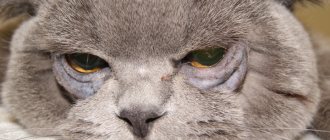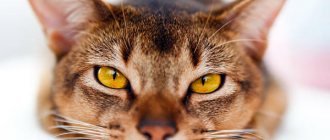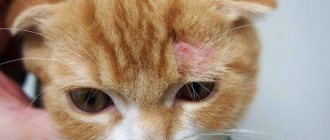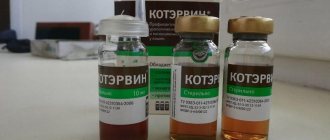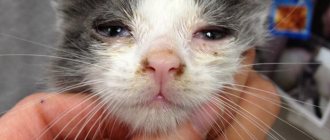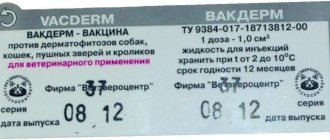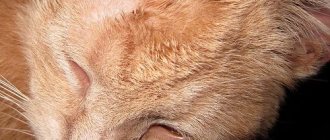Infectious respiratory diseases of domestic cats are common throughout the globe. They threaten the health of pets and cause a lot of trouble for owners. Viral rhinotracheitis, or feline herpes, is a disease with dangerous complications, although its first symptoms resemble a common cold.
- 2 Routes of infection
- 3 Symptoms of feline herpes
- 4 Diagnosis of the disease
- 5 How to treat rhinotracheitis in cats at home
5.1 Video with veterinarian recommendations for caring for a cat with rhinotracheitis
- 5.2 Features of treatment for kittens
What is viral rhinotracheitis
Respiratory disease in domestic and wild cats is caused by the feline herpes virus (Herpesvirus Type-1). The particle of the pathogen is called a virion and is a liquid capsule containing genomic DNA. On the outside, it is surrounded and protected by a protein shell. Above it is a lipid bilayer containing glycoproteins. In the cat’s body, viral particles begin to double and damage the mucous membranes of the eyes and upper respiratory tract. Inflammation of the sinuses, redness and swelling of the pharynx in sick kittens gave the name to the disease, registered in 1957 - Feline Viral Rhinotraccheitis (FVR). When a pet is infected, rhinotracheitis pathogen cells spread along the sensory nerves and reach the neurons. Here the virus stores its genomic DNA throughout the animal's life.
The causative agent of rhinotracheitis infects all cats
Feline rhinotracheitis is dangerous due to complications in individuals with weakened immune systems or other chronic diseases. In this case, the high activity of the virus causes tissue necrosis of the bronchi, digestive tract, nictitating membrane and cornea of the eyes. Inflammation is accompanied by a secondary infection caused by bacteria. The animal may go blind. If the nasal bone is destroyed or pulmonary edema develops, your pet will die.
The feline herpes virus strain exclusively affects cats. The owner of a pet with rhinotracheitis should not be afraid of infection. The disease is not transmitted to humans or other pets.
Cold and damp weather contributes to the spread of feline rhinotracheitis, because the virus is active only in a humid environment and dies immediately after drying out. At a temperature of +4°C, the pathogen is dangerous for more than five months, and when heated to +57°C, it is neutralized after 20 minutes. Virus particles that come into contact with the skin of a person’s hands are active for half an hour. Getting on toys, beds, food dishes, feline herpes serves as a source of infection for 8 hours. Home furniture becomes virus-free within 24 hours.
Outbreaks of rhinotracheitis occur at any time of the year with the appearance of a source of infection. Feral and abandoned cats living in cities migrate in search of food. In shelters for homeless animals, half of the pets get sick from one carrier. When kept in groups in nurseries, all individuals can get sick if the cats are in free contact with each other. The virus affects cats of all ages, but young animals and kittens are more often affected.
After suffering rhinotracheitis, the recovered pet becomes a latent carrier of the disease. Damaged mucous membranes of the respiratory tract are restored from the third week of illness. This occurs due to the animal’s immune system producing protective antibodies to virus particles.
Recurrence of symptoms of feline herpes is provoked by:
- weakened immunity due to a stressful situation;
- treatment with glucocorticoids;
- infection with other diseases;
- lactation.
In the chronic form of rhinotracheitis, the activity of the virus in the body of the sick animal does not stop. The reason is an insufficient amount of antibodies, inhibition of protective mechanisms. The pet constantly releases pathogenic particles into the environment and poses a risk of infection for healthy animals.
Consequences
If, when the first signs of the disease are detected, the owner does not begin timely treatment, then possible complications of rhinotracheitis in kittens may appear. The dangerous consequences of this disease include the following:
- Bronchitis and inflammation of the lungs (pneumonia) often occur;
- Severe damage to the nervous system occurs. This condition may be accompanied by stiffness of gait, muscle tremors, twitching of the limbs;
- Damage to the gastrointestinal tract may occur - constipation, intestinal weakness, diarrhea, diarrhea;
- Manifestation of regular secondary infectious processes;
- The development of leukemia and viral immunodeficiency is observed. In these cases, the mortality rate is 100%.
Find out more about the treatment and prevention of rhinotracheitis in cats in adulthood.
Routes of infection
The source of the feline herpes virus is sick cats, as well as latently infected animals without signs of disease. Within a day from the moment viral particles enter the respiratory tract of a pet, the pathogen begins to be released into the environment. It lasts up to three weeks. After the end of the acute period of the disease, the animal still poses a risk of infection to other individuals for more than six months.
The disease is spread by the following biological fluids:
- discharge from the eyes and nose;
- breast milk;
- saliva;
- sperm;
- blood;
- urine.
Particles of fur and skin from a cat with rhinotracheitis also contain the virus. All animal care items, including tools for trimming nails, combing fur, and cleaning ears, become a source of infection. There is a risk of your pet becoming infected when visiting a beauty salon or veterinary clinic. Feline herpes virus is usually transmitted to animals through close contact. Most often this happens when interacting with stray cats. Transmission of the disease through mating or participation in a show at an exhibition cannot be ruled out. Owners bring home viral particles on the soles of their shoes and become unwitting spreaders of the disease.
Kittens become infected with rhinotracheitis from a sick mother during birth. Less often - when feeding it with milk. The feline herpes virus does not cross the placental barrier and does not affect babies in utero. During delivery, kittens cannot avoid contact with the mother's biological fluids containing viral particles and antibodies to them. Therefore, the infection becomes noticeable after 20 days.
How can an animal get sick?
Often, a cat becomes infected by inhaling air containing the pathogen. However, a nutritional method of infection cannot be ruled out (this is when the virus enters the body with food). But the virus enters the air from the body of cats, which are either clearly sick or have already recovered and have been carriers for many months.
The rhinotracheitis virus enters the external environment with secretions from the nose, eyes, urine, feces and milk.
Your cat doesn’t have to have contact with the animal; you can be the “culprit.” Step on fresh cat excretions with the virus (let’s face it, you’re unlikely to notice a puddle of urine on the sidewalk or on the ground), and then use your shoes to carry it home.
Your pet will sniff or lick the shoes and become infected as a result. The first symptoms appear quite quickly, and they are quite specific.
Diagnosis of the disease
When examining the animal, the doctor pays attention to the characteristic clinical signs of feline rhinotracheitis and questions the owner about the development of the disease. A distinctive sign of viral herpes is damage to the cornea. To clarify the diagnosis, the veterinarian uses a fluorescent dye to look for ulcers in the clear area of the eye located above the pupil.
The blood test of a cat with rhinotracheitis showed an increased number of neutrophils and monocytes. Additional diagnostics include taking samples of mucous discharge from the nose and eyes and identifying virus particles or antibodies to them.
Laboratory methods for determining feline herpes virus:
- immunofluorescence reaction (RIF);
- histochemical examination;
- linked immunosorbent assay;
- polymerase chain reaction (PCR).
Immunofluorescence reaction is used to detect fragments of the virus and antibodies to it. After collecting biological material from a sick animal, the analysis result is obtained after 1.5 hours. Enzyme immunosorbent and histochemical tests detect viral antigen in damaged cells. They are also available, but take longer. Detection of a DNA fragment of the feline herpes virus by PCR reveals not only the active disease, but also latent carriage, including after vaccination. This makes it difficult to establish an accurate diagnosis, which is a significant drawback of this type of laboratory test. In addition, PCR diagnostics are expensive and are used only in large cities.
Rhinotracheitis differs from other respiratory infections and colds by the rapid increase in symptoms of runny nose and inflammation of the eyes. The disease is similar in clinical signs to calicivirus and chlamydia, which affect the respiratory and visual organs. But rhinotracheitis does not cause lameness, which is characteristic of the feline whooping cough virus from damage to bone tissue. With chlamydia, there are no ulcers on the cornea of the eyes, although inflammation of the conjunctiva is present.
How to treat rhinotracheitis in cats at home
It is impossible to destroy the virus in a pet's body. There is no cure for complete recovery. Treatment of the disease is to buy time until the animal's immune system begins to create antibodies to the viral particles. The use of medications is aimed at preventing complications and relieving pain during the inflammatory process.
To combat viral rhinotracheitis in cats, eye drops and ointments containing chloramphenicol or tetracycline are used. Dexamethasone and hydrocortisone, which slow down the regeneration of damaged tissue, . Immunomodulating drugs, for example, Poludan, are instilled into the eyes and nose. Albucid has an antiseptic effect on mucous membranes.
To prevent secondary complications, the doctor prescribes intramuscular injections of antibiotics:
- Bicillin-3;
- Ceftriaxone;
- Benzathine;
- Ampicillin;
- Cefazolin.
Administer twice a day, dividing the daily dose in half. The course of treatment is 5–10 days, depending on the severity of the sick pet’s condition. Vitamin preparations support the body's resistance to the toxic effects of the virus. In the early stages of the disease, antiviral serums help. They are used as prescribed by a doctor.
When liquid secretions are released from the eyes and nose, the animal loses not only moisture, but also proteins, which interferes with the restoration of damaged mucous membranes. The pet is given lysine between feeding periods, which stimulates the growth of epithelial cells. To reduce irritation of the eyes and nose, wipe them with cotton pads and warm saline solution every 2-4 hours. The air in the room with a sick animal is periodically humidified.
Video with veterinarian recommendations for caring for a cat with rhinotracheitis
The use of Immunofan, Vitafel and other drugs that affect the pet’s immune system does not inhibit the multiplication of the virus. Most veterinarians do not include them in the treatment regimen for rhinotracheitis.
Many difficulties arise when treating pregnant cats. In this case, the mother’s life is saved, without paying attention to the toxicity of medications for babies. When there were only two weeks left before the birth, my friend’s cat began to sneeze, her temperature rose, and after a day she refused to drink or eat. The owners went to the veterinarian without her, fearing the added stress of the trip. The doctor, having learned the address, immediately assumed infection with feline herpes - an animal living in the neighborhood was brought to him a week ago. His laboratory analysis confirmed viral rhinotracheitis. In addition to vitamins, Klaforan injections and antiseptic eye drops, the veterinarian prescribed treatment of the cat’s oral cavity with Collargol (silver with albumin). The doctor advised me to carry out allergy tests for all prescribed medications: spread the solution on the nose and wait 20 minutes to see if there is any redness. Another sign of increased sensitivity is excessive sneezing. The test showed normal tolerability of the drugs. But treatment is useless if the animal weakens before our eyes from hunger and dehydration. The veterinarian recommended liquid and thoroughly crushed food. Mousses and pates were diluted with warm broth and inserted into the corner of the mouth, behind the cheek, with a syringe without a needle. The cat swallowed some of the food and spat out some of it. The first four days there was no improvement, but the owners did not give up. The sick cat's diet was changed: they bought baby veal puree, heated it and let it lick it off the finger. The owner tried to feed her in small portions every hour during the day and at least once at night. And after 5 days the sick cat’s condition improved. Recovery was now a matter of time. The kittens were born on time, but the cat could not feed them. She became weak and there was no lactation. The babies were outwardly healthy and ate the formula with gusto. But after three weeks, everyone began to have watery eyes and sneezing. Now the kittens also had to be treated for rhinotracheitis, which they suffered more easily than their mother.
If a pet with feline herpes has a low fever or shortness of breath and wheezing, you should immediately consult a doctor. No less life threatening is refusal of food and water for three days, which requires intravenous administration of drugs and nutritional solutions. In this case, hospital treatment will be required.
Features of kitten treatment
Infection with feline herpes is very dangerous for young kittens, whose immune systems are not yet fully developed. The mortality rate for this disease is up to 30%. The greatest threat for babies is the loss of an eyeball, destroyed by the virus due to lack of treatment. To prevent such a complication, when washing the eyes, gently massage the eyes, instill antibiotics more often, and apply ointments 10 minutes after administering the drops. The procedure is repeated at least 4-5 times a day. To correctly calculate the dose of drugs, the kitten is weighed daily. Otherwise, the treatment does not differ from the regimen for adult animals.
A few facts about this disease
Every cat owner needs to know the basic facts about this disease. Firstly, a pregnant cat, having become infected with the herpes virus, infects its kittens in the womb. Secondly, it is very dangerous if the virus spreads to the eyes. Treatment in this case must begin immediately, otherwise the cat may lose its vision. Thirdly, if an animal is diagnosed with rhinotracheitis, it is necessary to carry out serious disinfection at home. Everything that the animal had access to needs to be treated: floors, carpets, blankets, furniture.
Preventive measures
To prevent cats from becoming infected with viral rhinotracheitis, it is enough to follow sanitary standards for caring for animals. If you entered the house from the street, put your shoes in a closet with the doors closed, and do not forget to wash your hands. Avoid contact with stray animals. A new pet must be quarantined in a separate room for 2-3 weeks, after which it is allowed into a group with healthy cats.
Vaccination is the main preventive measure to prevent the spread of the feline herpes virus. Healthy kittens are vaccinated from the age of three months or after changing teeth. The use of a vaccine stimulates the immune system to produce antibodies and prepares it to quickly respond to future infection. Live fragments of the virus contain the vaccines Leucorifellin and Felocel. Kittens are not vaccinated with them due to the appearance of a runny nose and watery eyes within two weeks after vaccination. It turns out that animals actually become ill with rhinotracheitis. Inactivated vaccines Quadricat and Nobivak, in which pathogenic microorganisms are killed, are safer. After vaccination, it takes time for the pet’s immunity to provide protection against the disease.
Unfortunately, the vaccine only protects against the type of virus included in it and does not prevent infection with another type of feline herpes. Therefore, it is not completely effective. The pet will get sick, but the illness will be less severe. Animals that have recovered from viral rhinotracheitis are vaccinated annually to avoid relapses of the disease.
Viral rhinotracheitis poses a danger to domestic cats due to its transience. Sometimes the disease leads to irreparable consequences. It is better, without wasting time, to take your pet to an appointment with a veterinarian and follow the entire prescribed treatment regimen. A caring and patient attitude towards an animal during illness will speed up its recovery.
Prevention measures
We looked at the symptoms and treatment of this virus. But is it possible to prevent the development of the disease in your pet? There is only one prevention - timely vaccination. The vaccine against rhinotracheitis, which is injected into cats, comes in two types: live and inactivated. The first begins to act four days after vaccination. Moreover, in the first week cats become carriers of this virus, so it is advisable to protect them from other animals. Also, when vaccinated with a live vaccine, post-vaccination reactions may occur.
When vaccinated with an inactive vaccine, revaccination is required after 3 weeks. But the effect of such a vaccine lasts for a year.
Multifel-4
is a vaccine against rhinotracheitis and other diseases. Small kittens are vaccinated with it, repeating revaccination after 3 weeks. Adult cats are vaccinated annually. The vaccine against rhinotracheitis must be given to all cats: both those walking on the street and those sitting at home (after all, there is a risk of catching the virus from, for example, human shoes).
The consequences of rhinotracheitis, as well as the course of the disease, can be severe, which is why it is so important to take all preventive measures. In addition to annual vaccinations, the cat must be properly maintained. It should not be overcooled or exposed to drafts. The animal must eat properly; vitamins and minerals must be included in the diet. It is important to protect your pet from stress that can undermine its immunity.

